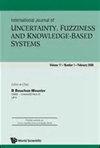当使用遗传takagi-sugeno模糊模型建模鱼类栖息地偏好时,缺失数据是否重要?
IF 1
4区 计算机科学
Q4 COMPUTER SCIENCE, ARTIFICIAL INTELLIGENCE
International Journal of Uncertainty Fuzziness and Knowledge-Based Systems
Pub Date : 2012-09-11
DOI:10.1142/S0218488512400223
引用次数: 3
摘要
在为目标物种或生态系统设计管理计划时,物种分布的信息是至关重要的。本文利用遗传Takagi-Sugeno模糊模型阐述了缺失数据对鱼类生境预测和生境偏好评价的影响。从日本一条农业运河进行的一系列鱼类栖息地调查中编制了三个独立的数据集。为了量化缺失数据的影响,利用完整数据和存在数据两种丰度数据建立了模糊生境偏好模型(FHPM)。结果表明,三个数据集的栖息地偏好曲线相似,而整个数据集的栖息地偏好曲线因数据集而略有差异。存在度数据得到的fhpm具有较高的泛化能力,支持了存在度数据可以更好地从野外观测数据中提取目标物种的栖息地偏好信息。本文章由计算机程序翻译,如有差异,请以英文原文为准。
DO ABSENCE DATA MATTER WHEN MODELLING FISH HABITAT PREFERENCE USING A GENETIC TAKAGI-SUGENO FUZZY MODEL?
Information on species distributions is of key importance when designing management plans for a target species or ecosystem. This paper illustrates the effects of absence data on fish habitat prediction and habitat preference evaluation using a genetic Takagi-Sugeno fuzzy model. Three independent data sets were prepared from a series of fish habitat surveys conducted in an agricultural canal in Japan. To quantify the effects of absence data, two kinds of abundance data (entire data and presence data) were used for developing a fuzzy habitat preference model (FHPM). As a result, habitat preference curves (HPCs) obtained from presence data resulted in similar HPCs between the three data sets, while those obtained from entire data slightly differed according to the data sets. The higher generalization ability of the FHPMs obtained from presence data supports the usefulness of presence data for better extracting the habitat preference information of a target species from field observation data.
求助全文
通过发布文献求助,成功后即可免费获取论文全文。
去求助
来源期刊
CiteScore
2.70
自引率
0.00%
发文量
48
审稿时长
13.5 months
期刊介绍:
The International Journal of Uncertainty, Fuzziness and Knowledge-Based Systems is a forum for research on various methodologies for the management of imprecise, vague, uncertain or incomplete information. The aim of the journal is to promote theoretical or methodological works dealing with all kinds of methods to represent and manipulate imperfectly described pieces of knowledge, excluding results on pure mathematics or simple applications of existing theoretical results. It is published bimonthly, with worldwide distribution to researchers, engineers, decision-makers, and educators.

 求助内容:
求助内容: 应助结果提醒方式:
应助结果提醒方式:


